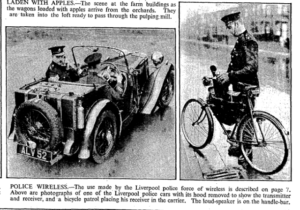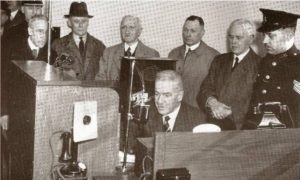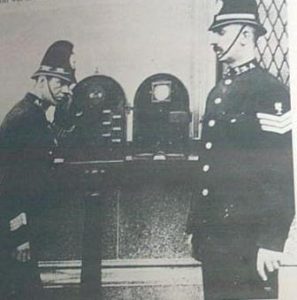WIRELESS RADIOS…. ITS HISTORY IN LIVERPOOL
Wireless radios were first introduced to Liverpool City Police in 1932 by the then Chief Constable, Archibald Wilson. Initially the radios transmitted and received in Morse Code and were very bulky. Liverpool City Police was the first Police Force to use radios in the UK.
In 1936 the radio had improved substantially allowing communication via speech and was again used by Liverpool City Police. The below article appeared in The Times newspaper on October 24th. 1936.
POLICE WIRELESS
VALUE IN DIFFICULT WORK
SUCCESS OF LIVERPOOL SYSTEM
From our correspondent
LIVERPOOL, Oct. 23rd 1936
Wireless as a help in the detection of crime and the capture of criminals is being used more and more by the Liverpool police force, to which it was introduced about four years ago by the Chief Con-
stable, Mr. A. K. Wilson, when he was called to that position.
Radio on police cars was at first looked upon by many with some doubt, but the authorities had faith in it, and they have gradually brought it to what it is today, a reliable method of facilitating police
work in some of its most difficult aspects. There was in the first instance a city area of 40 square miles to cover. but most of
the obstacles to progress have been removed. One remains: the short wave-length to which the Post Office restricts the system limits the power that can be used. On the American police there is no such restriction.
The first step in Liverpool was the erection of an aerial at the police transport headquarters in Seel Street. It was thought at first that the police headquarters in Dale Street might be used, but this building is surrounded by tramway lines and is in the centre of other electrical interference. Later the aerial was removed to Old Swan Police Station in the geographical centre of the city.
CYCLE RECEIVER
The system is worked in this way. The receiver on the police motorcar or cycle combination takes on its aerial the signals which come from the transmitter to whose wavelength it is tuned and turns them into more or less pleasant noises on the loud-speaker, but the receiver also picks up any smaller electrical disturbances from other sources lf they are of the same wavelength and of comparable strength, and this is one of the obstacles that have had to be contended with. The policy of the Post Office in allowing only limited power is regarded in Liverpool as one of the greatest obstacles to police wireless in this country, because the signals may be absorbed by steel buildings, overhead wires, or even the streets where there is a background of electrical disturbance.
The Chief Constable told me that the Liverpool transmitter has now become a police regional wireless station. As originally designed, it was to cover the40 square miles of Liverpool, but now there has been an extension to provide a wireless service for the police of the boroughs of Birkenhead, Wallasey, Bootle, Southport, and St. Helens, the Widnes and Runcorn divisions of the Cheshire Constabulary, and the city of Chester. The police wireless cars carry a transmitter so that they can communicate back to the transmitter at Old Swan. The motor-cycle combinations used in patrol work carry a receiver only, but within the last few months the Liverpool police have patented a small receiver for the patrol police; it is used by no other police force in the kingdom. It uses two valves, and the batteries are contained in a case which measures 6in. by 4in. by 3in., and weighs only 3lb. It is carried in the dispatch bag on the crossbar: of the pedal-cycle.
SPEECH AND MORSE
In Liverpool speech is used as the medium of transmitting messages. “on certain occasions Morse is used; but it is claimed that the use of speech makes it possible to bring any policeman into the scheme. All the officers on the cars and many of those on motor-cycle combinations and pedal cycles are Morse operators, but to restrict the system to Morse it would be necessary, in order to make effective use of every member of the force, to train large numbers of men.
The use of speech gets over the difficulty, and another advantage claimed for it is that in every police station in the wide area covered a receiver has been installed which takes all messages, as do the cars, motor-cycle combinations, and pedal cycles. The transmitter and equipment have been constructed by the Liverpool police, but owing to the extension of the system to outside areas it has been found necessary to place with firms the construction of some buildings and equipment. The pedal cycle receiver, which has been patented, gives good reception of speech up to 27 miles and of Morse up to 30 miles.
“ My idea of a police wireless system.” said the Chief Constable. ” is not that it shall be confined merely to dealing with such matters
as stolen cars. but that it shall be used for all purposes, and we want the public to make the fullest possible use of it by notifying us immediately when something calls for the intervention of the police. In order to get better results from the system over the now very much wider area, we are in course of moving the transmitter from Old Swan to the high ground at the Allerton municipal golf links.
The system has certainly been successful, and even greater achievements are in store for it.”




